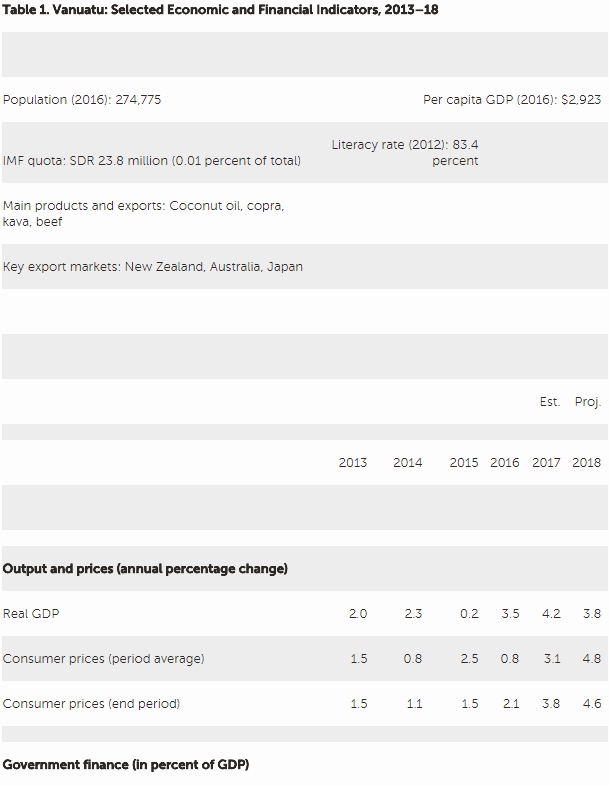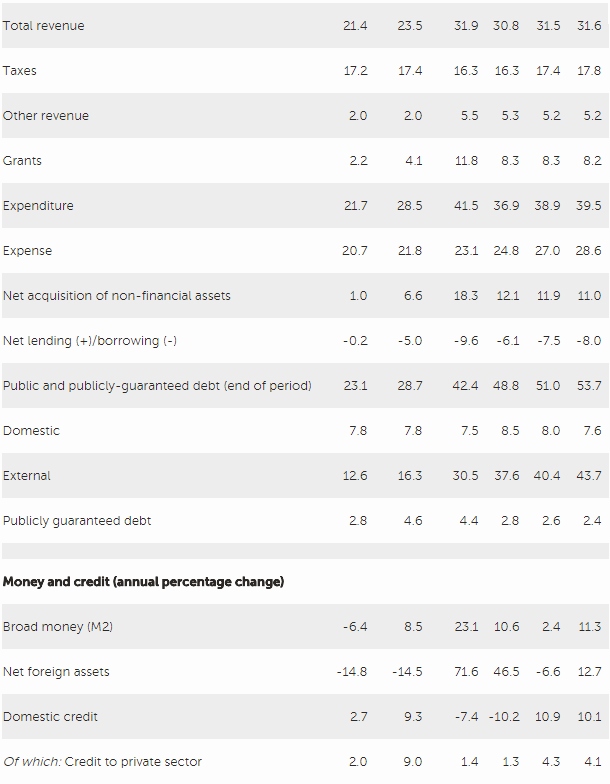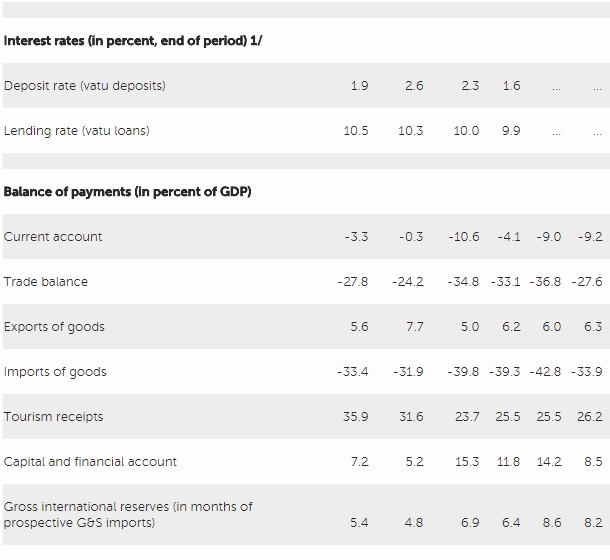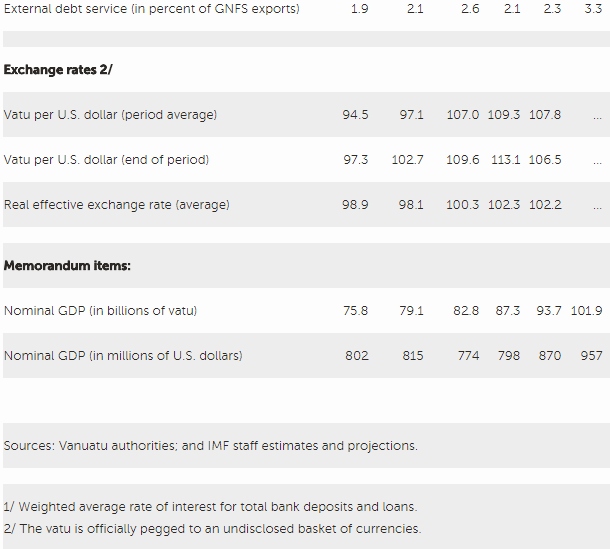IMF Executive Board Concludes 2018 Article IV Consultation with Vanuatu
On April 6, 2018, the Executive Board of the International Monetary Fund (IMF) concluded the Article IV consultation with Vanuatu, and considered and endorsed the staff appraisal without a meeting.
Vanuatu is poised to fully recover from the extensive damages caused by Cyclone Pam in 2015, with several large infrastructure projects near completion and growth bouncing back. Real GDP growth rebounded to 3.5 percent in 2016 from 0.2 percent in 2015, driven by recovery in tourism and agriculture combined with scaling-up of infrastructure. Inflation dipped below 1 percent in 2016 from 2.5 percent in 2015, due to low commodity prices. The current account deficit declined to about 4 percent of GDP in 2016 from 10.5 percent of GDP in 2015, due to rebounding exports and tourism activities.
A recovery in tourism and agriculture combined with further ramping-up of infrastructure projects is expected to propel real GDP growth to around 4 percent in 2017 and 2018. Inflation is estimated to pick up to 3.1 percent in 2017 driven by domestic demand, and rise further to 4.8 percent in 2018 mainly due to a temporary VAT increase, from 12.5 to 15 percent, before gradually reverting to modest levels in the medium term. The current account deficit is expected to widen to around 9 percent of GDP in 2017 and 2018, due to the high import content of infrastructure projects. The downside risks to this favorable outlook stem mainly from uncertainty in the rate of implementation of the public infrastructure projects and the ever-present danger of natural disasters.
The public and publicly-guaranteed debt increased sharply since 2014 mainly due to disbursements for reconstruction and infrastructure projects, though the new external borrowing was highly concessional. The fiscal deficit is expected to remain high at around 7 to 8 percent of GDP in 2017 and 2018, again reflecting elevated spending on reconstruction and infrastructure.
The accommodative monetary policy stance has played a crucial role in supporting economic recovery and financial stability after the cyclone. Over the past year, however, excess liquidity in the banking system has been associated with building up of inflation pressure. Financial sector remains sound, but there exists ample room to support financial inclusion. Private access to financial services for small and medium-sized enterprises (SMEs) and households in rural areas and outer islands has remained limited.
Executive Board Assessment
Reconstruction efforts from Cyclone Pam are near completion and full recovery is in sight. A recovery in tourism and agriculture combined with further ramping-up of infrastructure projects is expected to propel real GDP growth to around 4 percent in 2017 and 2018. The main risks facing the economy relate to the rate of implementation of public infrastructure projects, and the ever-present danger of major natural disasters.
Although tourism remains the center of economic activity, diversification of economic activity is vital to boost growth and help protect against the constant threat of major natural disasters. To this end, Vanuatu needs to segment the tourism sector strategically across locations and intensify efforts to diversify the economy out of tourism into the agricultural sector. For the diversification strategy to work, supporting the private sector by improving the ease of doing business is necessary. Improving access to employment opportunities and financial inclusion should remain priorities, including in the outer islands.
Internalizing the risks to growth associated with natural disasters and boosting the readiness to respond and manage their destructive force is critical to Vanuatu’s development strategy. Lessons from Cyclone Pam highlight that while the ex-post response was satisfactory, more ex-ante measures could be undertaken, including in the areas of resilient infrastructure, and improving coordination with development partners.
Vanuatu’s public debt acceleration in the wake of the Cyclone Pam reconstruction should be followed by well anchored medium-term fiscal adjustment. Once the reconstruction phase is over, the authorities should consider embarking on fiscal adjustment measures to address the rising debt and to rebuild fiscal buffers. These measures should include effective management of recurrent spending, prioritization and careful selection of infrastructure projects, and the mobilization of domestic revenue. The authorities should consider a medium-term fiscal anchor, defined in terms of a fiscal deficit target and debt ceiling, to provide guidance for policy choices.
Excess liquidity in the banking system and a buildup of inflation pressure over the past year call for monetary policy tightening. The RBV should tighten its monetary policy stance through a gradual increase of reserve requirements. The peg to an undisclosed basket of currencies continues to serve Vanuatu well in promoting stability and confidence. The external position remains broadly consistent with the medium-term fundamentals and desirable policies.
Increasing access to financial services should be a priority, focused on addressing the difficulties faced by SMEs and households in rural areas and outer islands in obtaining credit. Staff fully supports the authorities’ “financial sector architecture” initiative to address financial inclusion. While the financial sector remains sound, the RBV should stand ready to take action to secure financial stability by gradually normalizing regulatory requirements. Staff also welcomes authorities’ recent efforts to exit the FATF gray list and encourages them to ensure effective implementation of the AML/CFT framework to mitigate CBR pressures.




Source: International Monetary Fund
- 266 reads
Human Rights
Ringing FOWPAL’s Peace Bell for the World:Nobel Peace Prize Laureates’ Visions and Actions

Protecting the World’s Cultural Diversity for a Sustainable Future

The Peace Bell Resonates at the 27th Eurasian Economic Summit

Declaration of World Day of the Power of Hope Endorsed by People in 158 Nations

Puppet Show I International Friendship Day 2020

